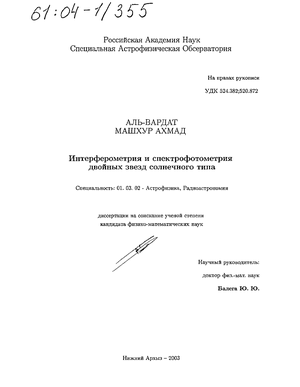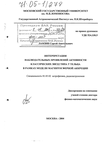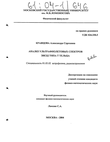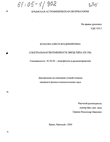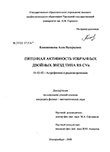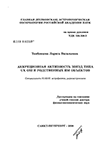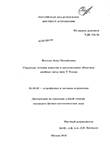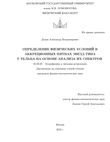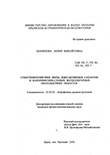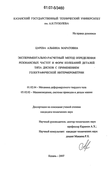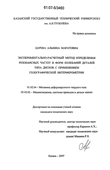Содержание к диссертации
Введение
1 The Astrophysical Problems of Studying Binary Stars 15
1.1 Milestones in the history of binary stars 15
1.2 Classification of binary stars 17
1.3 Binary star formation mechanisms 18
1.4 Statistics of binary stars and their catalogues 21
1.5 Conclusion 25
2 Speckle Interferometry of Binary Stars 28
2.1 Introduction 28
2.2 Qualitative description 29
2.3 Theoretical description 30
2.4 Programme of the stars 34
2.5 Observations and data analysis 36
2.6 Results and discussion 38
2.6.1 HIP 689 38
2.6.2 HD 25811 (BAG 4) 41
2.6.3 COU 1289 44
2.6.4 COU 1291 47
2.6.5 41 Dra 50
2.7 Conclusions 54
3 Spectrophotometry of Binary Stars 55
3.1 Introduction 55
3.2 Programme of the stars 56
3.3 Observations and data analysis 56
3.4 Results and discussion 61
3.5 Conclusions 76
4 Physical Parameters of the Components of Binary Stars 77
4.1 Introduction 77
4.2 The quadruple system ADS 11061 80
4.2.1 Observational results 82
4.2.2 Atmospheric modeling and discussion 86
4.3 The two systems COU 1289 and COU 1291 95
4.3.1 Observational results 96
4.3.2 Atmospheric modeling and discussion 98
4.4 The system HD 25811 105
4.4.1 Observational results 105
4.4.2 Atmospheric modeling and discussion 108
4.5 The system HIP 689 113
4.5.1 Observational results 113
4.5.2 Atmospheric modeling and discussion 116
4.6 Conclusion 121
Conclusion 123
Bibliography 129
- Classification of binary stars
- Programme of the stars
- Observations and data analysis
- Atmospheric modeling and discussion
Введение к работе
The correlation between spatial locations, dynamical characteristics, ages and metallicities of the main sequence stars is the key for the understanding of the chemical and dynamical evolution of our Galaxy. But even in the vicinity of the sun (d 50 pc), this correlation still remains hardly vague because of the big uncertainties in the determination of the main stellar parameters (Andersen J. 1991,1998).
Nearby stellar populations are occupied mainly by dwarfs of F, G, К and M spectral types, with metallicities in the range -1.0 [Me/H] +0.3. More than 50% of these stars are members of binary and multiple systems(Abt $z Levy 1976; Duquennoy &: Mayor 1991). For such unrecognized systems, natural uncertainties in the determination of photometrical parallaxes, masses, ages and metallicities might be the main reasons of scattering of the points in the known statistical dependencies (Nordstrom et al. 1999).
Most of the unrecognized binary and multiple systems are of the young rapidly rotating main sequence F-stars. For which, the radial velocities as well as the existence of a companion is difficult to define by spectroscopy. Also young F-dwarfs, which have not had enough time to leave their forming regions, are quite important for metallicity distribution studies. Generally, such problem can be solve only by means of interferometric and spectrophotometric observations.
Unresolved binaries, for which separate determination of spectral and photometrical properties is impossible, are usually excluded from observational programs and statistical analysis of normal stars. But big part of the unrecognized multiple systems can significantly change dependencies such as mass-luminosity, mass-radius, age-luminosity and scale of effective temperatures. Moreover, statistical properties are directly connected with the stars formation, but accuracy in such relationships is not enough for the investigation of the modern theories of stellar formation and evolution.
So, the complex study of binary and multiple systems by different observational methods have in principal significant importance in the determination of the main features of the different types of stellar populations in the Galaxy.
Binary systems give a unique possibility for the direct determination of the complete set of stellar parameters without depending on any statistical relations. Such possibility, however, can only be applied for objects having a possibility to be observe by means of different observational methods.
Progress in observational techniques and data processing have greatly increased the number of binary and multiple systems available to the complex studies. This provides a possibility of revision of the statistical dependencies on the basis of the direct determination of the complete set of fundamental parameters of the components of these systems. These parameters are defined by parallax measurements, interferometry, radial velocity measurements and spectrophotometry.
Hipparcos catalogue (ESA, 1997) is the most full and reliable source of the information about stellar parallaxes - it contains more than 20000 parallax measurements for nearby stars with distance estimation errors better than 10%. However, binary systems parallax determinations were distorted by their orbital motions, the reason why their real accuracy was much lower than those of single stars. So, Speckle-Interferometry remains the main method of determination of binary stars visual orbits.
In the Fourth Catalogue of Interferometric Measurements of Binary Stars (http://ad/-usno.navy.mil/wds/mt4.html), one can find more than 28600 observations, made at different telescopes. In comparison with the classical methods of studying visual binary stars, interferometry enables the measurements of less separated systems with higher accuracy.
The only mission which has more observations than speckle-interferometry is Hipparcos, but it had a lower accuracy, larger limited separation and insufficient mission lifeime for reconstructing of the orbits. Concerning long-base interferometry, its advantages of high precision and resolution were restricted by low sensitivity and small number of observations.
Speckle-interferometry also enables us to measure the magnitude differences. But due to methodical problems, high-precision Am speckle-measurements were not possible until recent time (Worley et ah 2001). So, such measurements have been obtained only episodically by means of different algorithms in random photometrical bands. The precision of these measurements was not better than 07 2, and it is even difficult to estimate their reliability.
Differential photometry of binary stars was made by HIPPARCOS, but for pairs as faint as 10"1 — 12m with separation less than (X 3, errors were comparable with the measured values. The method of Am definition carried at SAO RAS via speckle-interferometry provides magnitude differences measurements for systems brighter than 13m with Am 4m and precision about СГ 05. For pairs wider than 0/3, interferometric errors are comparable to those of HIPPARCOS, but for closer pairs they are much smaller (Balega et al. 2002).
Interferometric binary orbits combination with the components radial velocities provides direct masses and parallaxes estimations with precision much better than any other method.
Systematic monitoring of several thousands of nearby solar type stars is carrying out with the velocity measuring device CORAVEL in both north and south hemispheres (Duquennoy & Mayor 1991; Halbwachs et al. 2003). Significant part of these objects (pairs with orbital periods from several hundreds of days till decades) are the candidates for speckle-interferometric measurements on the largest telescopes.
The combination of interferometric Am results with the spectrophotometry data allows to build individual model atmospheres for each component of a binary system. The Result of such measurements is the determination of the statistical dependencies for stars of different types with accuracy enough for theoretical researches.
Thereby, the actuality of the dissertation s task raised from the necessity and opportunity to improve statistical dependencies for F, G and К stars, a knowledge will improve - in its turn - the understanding of the formation and evolution of single and multiple stars and clusters of stars in different parts of our galaxy.
The main goals
The main goals of the dissertation are:
1. To develop a method of direct determination of the complete set of the fundamental parameters of the components of a binary system on the basis of the combination of speckle-interferometric and spectrophotometric observations with the radial velocities and parallaxes measurements.
2. To make a catalogue of spectral energy distributions of the main-sequence F,G and К speckle-interferometric binaries, to estimate their colors and to reinvestigate their entire spectral types.
3. To observe several chosen objects by means of speckle-interferometric techniques in order to reconstruct their visual orbits, measure their Дт and obtain their absolute magnitudes.
4. To build individual spectral energy distributions for the components the selected systems by means of atmospheres modeling combination with their measured magnitude differences and known parallaxes. Hence, to determine their complete set of fundamental parameters: effective temperatures, luminosities, spectral types, masses, gravity accelerations and ages.
5. To investigate advantages and restrictions of the developed method in the revision of the existing statistical dependencies.
New scientific results
To developed method of direct determination of the fundamental stellar parameters was investigated on the basis of the combination of speckle-interferometric and spectrophotometric observations of binary systems.
Composite spectral energy distributions of 46 speckle binary stars were measured for the first time. The measurements were made at the Cassegrain focus of the Carl Zeiss Jena (Zeiss-1000) 1 m telescope of SAO. The measured SED s covered the range between 3700A and 8300A. The BVR magnitudes A good agreement has been found between the calculated colour magnitudes and colour indices and those of Hipparcos and Tycho catalogues. Also a comparison of the estimated spectral types with those given by SIMBAD (http://simbad.u-strasburg/Simbad) shows a good agreement for most of the stars within the error values of В — V. and the В — V colour indices for all of the 46 stars were calculated, and their composite spectral types were estimated.
New relative positions of five speckle interferometric binary systems were measured using the speckle interferometric techniques at the 6-meter telescope of the Special Astrophysical Observatory (SAO RAS), these are: 41 Dra, COU 1289, COU 1291, HD 25811 HIP 689. For the first time, modified orbital elements of these stars were obtained. Their magnitude differences were estimated and they were combined with Hipparcos parallax (ESA 1997) and the known entire V magnitude to calculate the absolute magnitudes of their components, and hence their spectral types.
For the first time, individual theoretical SEDs were build for each of the two components of the binary systems: 40 Dra, 41 Dra, COU 1289, COU 1291, HD 25811 and HIP 689. The method used Kurucz (1993) line-blanketed plane-parallel model atmospheres combination with the results of speckle interferometry and spectrophotometry.
Presentations
The main results of this work were presented in the following international conferences and seminars:
The Second Arab Astronomical Conference (Amman, Jordan; 8-10 September 1997);
The First All-Russian Astronomical Conference (Saint Petersburg; 6-12 August 2001);
IAU Symposium No. 210, Modelling of Stellar Atmospheres (Uppsala, Sweden; 17-21 June 2002);
The 5th Arab Astronomical Conference & The 3rd Conference for AUASS (Amman, Jordan; 19 - 22 August 2002);
The sstrophysical seminars at the Special Astrophysical Observatory (SAO) (Nizhnij Arkhyz), and at the Higher Institute of Astronomy and Space Sciences, АІ al-Bayt University, Mafraq, Jordan.
Main items proposed for defense
1. The results of spectrophotometric study of 46 speckle interferometric binary systems, which include their entire spectral energy distributions in the range 3700-8400 A, BVR Johnson-Cousins magnitudes, В — V magnitude differences, and their entire spectral types.
2. The results of speckle interferometric measurements of 41 Dra, COU 1289, COU 1291, HD 25811 and HIP 689, which include measurements of their relative positions, determination of their orbital parameters, mass sums and magnitude differences.
3. Results of the combination of speckle interferometry and spectrophotometry with the atmospheres modeling to estimate the fundamental parameters of the components of 40 Dra, 41 Dra, COU 1289, COU 1291, HD 25811 and HIP 689. The parameters include their spectral types, luminosities, effective temperatures, radii, masses, gravity accelerations and ages.
Personal input of the author
Speckle interferometric observations and data reduction were made together with the group of The Laboratory of High Resolution in Astronomy (SAO RAS). The final estimations and results were made by the author.
All spectrophotometric observations, data reductions, atmospheres modeling and results extraction were made by the author.
Contents of the dissertation
This dissertation consists of introduction, four chapters, conclusion, bibliography of 121 items, and appendix. It consists of 145 pages including 54 figures and 54 tables.
In the Introduction the importance of the work was explained in addition to the actuality, the main goals, the new scientific results, the presentations, the main items proposed for defense, the personal input of the author, a brief contents of the dissertation and a list of the author s publications.
In the 1st chapter The Astrophysical Problems of Studying Binai-y Stars brief review of modern knowledge in the field is given, including relationships between fundamental stellar parameters and the formation and evolution theories. Conclusions were made about the low precision of the statistical dependencies of mass-luminosity, mass-radius, age-luminosity and the scale of the effective temperatures with the comparisons of theoretical models. The concepts of improvement of these statistical dependencies were discussed on the basis of the complex study of visual close binary stars which depends on the combination between speckle interferometry, spectrophotometry, radial velocities and parallaxes. At the end of the chapter, the stars selection criteria to apply the direct method of estimation of the fundamental parameters were discussed.
In the 2nd chapter Speckle Interferometry of Binary Stars, description of the speckle interferometric method of measuring relative positions and magnitude differences of binary and multiple systems is presented.
The method enabled us to achieve high accuracy measurements of the relative positions of binary stars using large ground based telescopes.
Although diffraction limit of the telescope a = 1.22Л/Д is only several milli-arc-seconds (0/02 in the case of BTA), resolution of ground telescopes is rarely more than 1".
The main reason which decreased the resolution is the turbulence of the earth atmosphere. However, at exposures comparable to the atmospheric turbulence time (which freeze the atmospheric degradation), monochromatic images of the stars powerfully save information with the diffraction limits of the telescope.
The statistical processing method proposed by Labeyrie A.( 1970) enables obtaining power spectra or auto-correlation functions of the set of instant images of the source. In the case of binary stars, the method made it possible to determine relative positions and relative intensities of the components using geometrical parameters and fringes contrast of the measured power spectrum.
The system used to obtain speckle interferometric data at the prime focus of BAT was discussed along with the procedures of processing the sets of speckle interferograms, determination of the relative positions and magnitude differences of the binary and multiple stars.
The method was applied to five binary systems: 41 Dra, Cou 1289, Cou 1291, HD 25811 and HIP 689. The results of observations performed in 2001 and 2002 include their relative position measurements with accuracy C. OQl- ОС ООЗ and magnitude differences with accuracy 0Г 04- 07 12 (Al-Wardat et al. 2003). Improved orbits for the five systems were archived using the new points along with those from the Fourth Catalog of Interferometric Measurements of Binary Stars, the new estimated orbital elements were compared with the other authors. Direct proof of 15 years period for the system COU 1289 was obtained, the system was resolved three times during the closest approach of its components when the angular separation was between 0V018 and 0 019.
The computed orbital parameters and magnitude differences were combined with the parallaxes, from Hipparcos, to derive the mass sums, the individual absolute magnitudes and the spectral types of the components. The accuracy of the estimated masses and absolute magnitudes depends, mainly, on the errors of the used parallax.
In the 3rd chapter Spectrophotometry of Binary Stars, a wide range ( 4500 A), low resolution (18 A, 6 A/px) spectrophotometry of 46 speckle interferometric binary stars were presented, where I got their entire spectral energy distributions, BVR magnitudes, В — V colour indices, and their entire spectral types. The objects of the study were taken from the speckle interferometric programme, which has been carried out at the 6-m BTA telescope of the Special Astrophysical Observatory since the early nineties. The programme mainly includes late type dwarfs in the vicinity of the Sun, which fundamental parameters are badly known.
Beside the direct results of these observations, a part of the presented data were used as a reference for building theoretical spectral energy distribution curves on the basis of Kurucz blanketed models. These along with the magnitude differences from speckle interferometric observations, were used to build spectral energy distributions for the components of the binary systems, from which we got their complete set of fundamental parameters (see chapter 4).
The stars were divided into three sets (Set A, Set В and Set C) according to the observational campaigns. The spectra were obtained using a low resolution grating (325/4° grooves/mm, 5.97 A/px reciprocal dispersion) within the UAGS spectrograph at the Cassegrain focus of the Carl Zeiss Jena (Zeiss-1000) 1 m telescope of SAO during the photometrical nights: January 28 and February 4, 2002 for set A; May 25, 26 and 27, 2002 for set B; and July 20 and 21, 2002 for set C. The seeing in all nights was around 1.5". The stars are listed in three tables, which include their different identifications, coordinates and times of observations in Julian Date.
The used spectrograph has an 1SD015A 530x580 px CCD detector, its parameters and sensitivity curves at the blue and red parts of the spectrum are shown in the chapter.
A well known standards were used for the calibration and investigation of the external agreement of the system. The standard deviation of В and V magnitudes, obtained for each star from the sample of the spectra, was typically better than 074)6, and for the R band it was better than СГ07.
The results of the measured flux, corrected for the atmospheric extinction, are listed in the Appendix and plotted in the chapter in units of erg/cm2 • s-A.
BVR synthetic magnitudes were computed using the zero points of the spectrophotometric calibration of Vega. For V band ZP was solved using the spectrophotometric calibration of Vega published by Hayes (1985) and the V magnitude of 07 03 measured by Johnson et al. (1966). While for В and R bands it was solved using the Vega magnitudes published by Hamuy et al. (2001) as В = 07Ю14, and R = (Г042.
A good agreement has been found between the calculated colour magnitudes and colour indices and those of Hipparcos and Tycho catalogues.
The entire spectral types of the binaries were estimated by comparing В — V with the intrinsic colours of FitzGerald (1970). The comparison of the estimated spectral types with those given by SIMBAD showed a good agreement for most of the stars within the error values of В — V.
In the 4th chapter Physical Parameters of the Components of Binary Stars, I presented the study of six binary systems (the quadruple system ADS 11061, the binary systems COU 1289, COU 1291, HD 25811 and HIP 689) as examples for the combination method of atmospheric modeling with the observational results of speckle interferometry and spectrophotometry to estimate the fundamental parameters of their components.
The description of each system started by introduction about the system includes its importance in such study, list of data concerning the system from different sources like SIMBAD, Hipparcos and other sources. Followed by individual description of spectrophotometrical results.
Using the magnitude differences from the results of speckle interferometry and the entire visual magnitudes from the spectrophotometric results, the individual magnitudes of the components were calculated. These along the parallax were used со calculate the absolute visual magnitudes, from which we estimate the preliminary effective temperatures, radii and gravity accelerations. This allows construction of model atmospheres for each component using the grid of the Kurucz {1994) blanketed models.
The entire SED s of these pairs from the spectrophotometric results were used as a reference for the best fitting with the theoretical ones, and for the feedback of the parameters of their components. Hence the complete set of parameters of each component were estimated including: effective temperature, luminosity, spectral type, mass and gravity acceleration.
The positions of systems components on the evolutionary tracks and isochrones of Girardi et al. (2000) were assigned, and their ages were estimated. Formation and evolution of the systems were discussed according to the formation theories, where filament fragmentation was proposed as the most likely process for the formation and evolution of the quadruple system ADS 11061, and Fragmentation was proposed as the most likely process for the formation and evolution of the systems COU 1289, COU 1291, HD 25811 and HIP 689.
In the Conclusion, the main results of this work were listed.
Particulary, we developed a complex method of estimation of the fundamental stellar parameters of the components of binary and multiple systems of stars. The method depends on the combination between speckle interferometry, spectrophotometry and atmospheres modeling.
The method uses the magnitude differences between the components and the mass sums of the systems measured by means of speckle interferometry with the entire spectral energy distributions and apparent magnitudes of the systems measured by spectrophotometry to build individual theoretical SED for each of the subcomponents using Kurucz (1993) line-blanketed plane-parallel model atmospheres. From which we estimate the complete set of the fundamental parameters of each component of a binary system.
The method was applied to a sample of six speckle interferometric binary systems of the nearby Fype dwarfs, these were: 40 Dra, 41 Dra, COU 1289, COU 1291, HD 25811 and HIP 689.
The orbital elements of the studied systems, their magnitude differences, absolute magnitudes, mass sums and spectral Types were estimated in addition to the the complete set of the individual fundamental parameters of the components (effective temperatures, luminosities, spectral types, masses, gravity accelerations and ages).
The estimated parameters forms the most detailed and accurate ones ever estimated for the studied systems. Comparisons with the known relations for disk lateype dwarfs has been made.
In addition we got the entire SEDs for 46 speckle-interferometric main sequences binaries. These data give an opportunity to improve statistical dependencies for the nearby stellar populations. The results can be used for the study of formation and evolution of binary and multiple systems.
The Appendix includes the tables of the spectral energy distributions for the 46 stars studied in chapter 3.
Publications of the author
1. Al-Wardat M.A., Al-Naimiy H.M., Barghouthi I.A., and Sabat H. New physical and geometrical elements of some x-ray binary stars, Astrophysics and Space Science, 260; 335-345, 1999.
2. Sabat H., Al-Naimiy H.M., Barghouthi I.A., and Al-Wardat M.A. Synthetic light curve of some X-ray binary stars, Astrophysics and Space Science, 260; 347-357, 1999.
3. Al-Wardat M.A., Balega LI., Balega Yu.Yu., Lueshin V.V., Pluzhnik E.A., Shkhago-sheva Z.U., The system 41 Draconis: approaching priastron on 2001, Proceedings of All-Russian Astronomical Conference (Saint Petersburg; 6-12 August 2001).
4. Al-Wardat M.A., Balega Yu.Yu., Leushin V.V., Monin D., Pluznik E.A. The Complex Study of the Quadruple System ADS11061, Proceedings of the IAU Symposium No. 210 Modelling of Stellar Atmospheres (Uppsala, Sweden; 17-21 June 2002).
5. Al-Wardat M.A. Spectral energy distributions and model atmosphere parameters of the quadruple system ADSl 1061, Bull. Spec. Astrophys. Observatory, 53, 51-57,2002.
6. Al-Wardat M.A. Spectrophotometry of speckle binary stars, Bull. Spec. Astrophys. Observatory, 53, 58-77, 2002.
7. Al-Wardat M.A. Spectrophotometry of speckle binary stars II, Bull. Spec. Astrophys. Observatory, 54, 29-45, 2002.
8. Al-Wardat M.A. Spectrophotometry of speckle binary stars III, Bull. Spec. Astrophys. Observatory, 55, 18-37, 2003.
9. Al-Wardat M.A. Spectral energy distributions and model atmosphere parameters of the binary systems COU1289 and CO U1291, Bull. Spec. Astrophys. Observatory, Preprint
#185
10. Al-Wardat M.A. Model atmosphere parameters of the binary systems 41Dra, Bull. Spec. Astrophys. Observatory, Preprint # 186
11. Al-Wardat M. A., Balega Yu.Yu., Pluznik E.A., Shkhagosheva Z.U. Speckle interfero-metric results and modified orbits of five binary systems, Spec. Astrophys. Observatory, Preprint #190
Classification of binary stars
It is natural to classify such large number of stars into sub-classes to simplify their study. Many efforts were made in this field, over here we will display some of these schemes. One of the schemes classify binary stars according to the observational means into the following categories (Batten, 1992; Plavec, 1992): Visual binaries; the binaries which instantly seen to be double stars through the telescope- Although some of these pairs are chance alignment of stars at very different distances from us, many are genuine binary systems. Recognition of a visual binary depends not only on the true separation of its components, but also on its distance from the sun. So, at least those systems for which orbits may be determined, are relatively near neighbors. Spectroscopic binaries; the binaries which cannot be seen as double even through a large telescope, but one can recognize two spectra or periodic motion of one spectrum. They can be recognized at much greater distances than the visual binaries. Eclipsing binaries; the binaries which can be recognized by the variation of their light caused by mutual eclipses of two components. They can be recognized at even greater distances than the spectroscopic binaries if the eclipses are fairly deep, Astronomical binaries; the binaries in which the companion cannot be seen directly, but from the periodic motion of the brighter star its presence can be inferred. Interferometric binaries; the binaries which are best measured by studying the interference patterns produced by the two stars. There is an objection on this scheme of classification, however, is that it does not correspond to any obvious physical differences between the classes, i.e. a binary star may classified under more than one category. Another scheme classify binary stars according to the separation between the pair into the following categories (Batten 1992; Plavic 1992): Wide binaries; the binaries in which the separation of the two components is enough so that they don t affect each other evolution, like most of the visual binaries. Close binaries; the binaries in which the two components interact in many ways and affect each other evolution, under this category we may insert many of the spectroscopic, eclipsing, and unusual types of objects resulting from interaction between the components of the close binary , like cataclysmic variables and X-ray binaries. Binaries under this category can be classified into three sub-groups according to the Roche Model (Kopal 1959) : Detached systems; in which neither component fills its Roche lobe. Semidetached systems; in which the secondary fills its Roche lobe, while the primary (more massive ) star is smaller than the Roche limit. Contact systems; in which both components appear to fill their Roche limit. The capture theory: Proposed by G.J. Stoney (1867), as a two stars, originally independent, might approach each other under such conditions that each would be forced to revolve with the other about a common center of gravity. This theory in its original form has been completely abandoned as too unlikely (Zinnecker 2001). The tidal capture theory:
A modern version of the capture theory, applicable to dense star clusters such as globular clusters (Fabian Pringle &: Rees 1975) or the theory of gas drag in colliding protostars with extended disks or envelopes (Silk 1978). In fact, these processes may be at work in the core of young clusters to explain the high frequency of tight binaries among massive stars (Mermilliod & Garcia 2001). The separate nuclei theory: Advanced by Laplace in 1796. The fission mechanism: First discussed by Lord Kelvin and P.G.Tait in 1883. This theory describes the behaviour of a rotating,homogeneous, incompressible fluid mass, as a sequence of equilibria under gravitational contraction. In 1918, Jeans made a famous conjecture that fission is the formation process of close binaries, depending on Jacobi discovery in 1834 for the sequence of non-axisymmetric ellipsoidal figures of equilibria. Which with increasing rotation (angular momentum) become egg-shaped and can bifurcate into two objects . While he favored the separate nuclei theory as the process by which wide binaries form, the dividing line lying at a period of 55 days, according to Jeans (Zinnecker 2001).Apart from Jeans, Henry Norris Russell (1910) had earlier supported the fission origin of hierarchical triple/quadruple systems (two bifurcations), In practice, fission does not seem to work. This became apparent when considering centrally condensed, differentially rotating fluid bodies (differentially rotating polytropes), which resemble stars much better than objects with uniform, solid body rotation. When the ratio of rotational to gravitational energy exceeds a critical value (ficrit = 0.27), the rotating fluid goes bar-unstable on a dynamical timescale (Bodenheimer & Ostriker 1973), and ejects spiral arms that transport angular momentum outwards, thus preventing fission from occurring. The modern theory of cloud fragmentation: A dynamic process in a collapsing cloud, where the breakup of molecular cloud cores during their self-gravitational collapse to form stars, is the leading explanation for the formation of binary and multiple protostars. Originally introduced by Hoyle (1953) and Hunter (1962) in qualitative and analytic terms, the modern theory of cloud fragmentation was made possible by numerical simulations (cf. Larson 1978). Hierarchical fragmentation during rotational collapse has been invoked to produce binaries and multiple systems and explain many of their observed properties (cf. Boss 1988). Cloud characteristics that generally are favorable for fragmentation include non-singular density profiles, a low degree of thermal pressure and magnetic field support, significant rotation, and the presence of external perturbations such as tidal forces (Boss 1992). Molecular cloud cores appear to be supported against collapse in large part by magnetic fields. However, most protostellar fragmentation calculations have either ignored the effects of magnetic fields or found that in the presence of frozen-in magnetic fields, fragmentation is prohibited. Allowing for magnetic field loss by ambipolar diffusion prior to collapse leads again to fragmentation, but these calculations did not take into account magnetic field tension, which effectively dilutes the self-gravitational forces once a thin disk forms. Because self-gravity drives fragmentation, magnetic tension might then prevent fragmentation (for more discussion see Boss, 2001). The dynamical properties of the systems of protostellar cores formed by fragmentation appear to be in agreement with the ranges of these properties as determined by observations of binary and multiple pre-main-sequence and main-sequence stars (Boss 1992).
Fragmentation can be divided into two modes: Filament fragmentation: Or thermal driven fragmentation as called by Bonnell (1994), can occur for non-spherical (e.g. prolate) clouds or from clouds that undergo cooling as they collapse. The fragmentation of prolate clouds, with initial conditions constrained from observations, can form binary systems with separations from 10 to 104 AU, with high eccentricities and a wide variety of mass ratios. Zinnecker (1989) pointed out that tumbling filaments, rotating end over end, would tend to fragment into binaries with high eccentricity, a conjecture borne out by numerical simulations (Bonnell & Bastien 1992). Whitworth and his students (Turner et al. 1995; Whitworth et al. 1995) follow numerically the outcome of impulsively triggered fragmentation. Disk fragmentation: Or rotationally driven fragmentation, can occur due to the rotational instability of the central object. This mode can form binary systems with separation from a few RQ to a few hundreds astronomical units Bonnell (1994). In both cases, the resultant fragment need to accrete a large proportion of their eventual mass and their evolution during this accretion phase will probably be the most important factor in determining the final binary parameters (Durisen 2001; Bonnell 1994). The theory of the disintegration of small star clusters: one also should not forget the the formation of binaries by the evolution of small clusters which looses their components. This would explain not only the binaries but also the triple, quadruple etc, systems, as the stable decay products of unstable mall N-body configuration. Its beginning goes back to a seminal paper by Van Albada (1968)(cf. Szebehely 1977).
Programme of the stars
The objects of the study were taken from the speckle interferometric programme, which has been carried out at the 6 m telescope of the Special Astrophysical Observatory since the early 90s. The programme mainly includes late type dwarfs in the vicinity of the Sun, and their fundamental parameters are badly known. The chosen stars are of the of the nearby fast orbiting Fype or suspected Fype stars for reasons discussed in the introduction. The same stars will studied again in the next chapters by spectrophotometry and atmospheres modeling to estimate the complete set of their components fundamental parameters. The systems are: HIP 689, HD 25811 (BAG 4), COU 1289, COU 1291, and 41 Dra. Table 2.1 contains the SIMBAD data of the systems, and Table 2.2 contains data from Hipparcos and Tycho Catalogues (ESA 1997). The observations were carried out at the 6-m BTA telescope of the Special Astrophysical Observatory. The detector of our visible speckle camera is an intensified Peltier-cooled 1280 x 1024 pixel CCD with a multialkali S25 intensifier photocathode. The maximum frame rate of the camera is 6 speckle interferograms per second. A microscope provides a scale of 6 mas per pixel. There are 7 filters available with the speckle camera, the central wavelengths, bandwidths and transparencies of these filters are listed in Table 2.3, and their transparencies Risley prisms were used for the compensation of atmospheric dispersion. Under good seeing conditions our detector allows the observations of binaries as faint as 15th magnitude. With the 6-m telescope we were able to resolve stellar companions as close as 20 mas. The image motion-compensated seeing (FWHM) was 1"0 - 175. Typically 1000 to 2000 speckle frames per object were taken with exposure times from 5 to 20 ms, The instrumental scale calibration was performed by recording interference fringes from a two-hole mask installed in a converging beam between the primary mirror and the focal plane; the projection of the distance between the holes on the mirror surface was 4968 mm. In our optical speckle interferometry (Labeyrie 1970) observations the relative position and magnitude difference of each binary was derived from the ensemble average of all power spectra of speckle interferograms without compensation of the atmospheric transfer function. However, in the case when a close binary at the diffraction limit of the telescope was expected, we observed a reference star for the compensation. To determine the magnitude difference, we measured the value A2 + B2/AB, where A and В are the relative intensities of the components, as a function of the spatial frequency for each circle around the center of the ensemble average power spectrum up to the diffraction cut-off frequency. The A2+B2/AB value represents the fringe contrast in the spectrum. The contrast of each circle intensity distribution depends on both the flux ratio A/B of the binary and the photon bias (Goodman & Belsher 1977). For bright binaries, the photon bias is weak and has small influence on the contrast of the fringes in the power spectrum. Therefore, in the case of bright pairs, the contrast is independent of the radius of the circles and the intensity distribution on each circle yields approximately the same value for the magnitude difference.
However, for faint objects, the additive photon bias function depends on the power spectrum circle radius (the photon bias decreases slowly from the centre to higher spatial frequences) as the photoevents are extended dots with a diameter of approximately 3x3 pixel. In this case the radius-dependent fringe contrast measurements are used to fit both the shape of the photon bias function and the magnitude difference of the binary. This method can only be applied if the power spectrum consists of more than 3 fringes. The 180 position angle ambiguity of the optical speckle interferometry observations was overcome by the Walker method (1981). The system HIP 689 (HD 375) was firstly resolved as a binary by Hipparcos (ESA 1997). After that it was included in the speckle interferometric program of the Russian 6-meter telescope by Balega & Balega (1987). Since then it is routinely observe by speckle interferometric techniques all over the world to achieve as much data as possible in order to calculate its best orbit (McAlister et al. 1987; McAlister et al. 1990; Bagnuolo et al. 1992; Balega et al. 1994; Balega et al. 2001). The estimated orbital parameters of the system HIP 689 are listed in Table 2.4 along with those of the preliminary orbit by Balega et al. (2002). The orbit (Fig. 2.6) was built using the relative position points from the Fourth Catalog of Interferometric Measurements of Binary Stars along with the three new points measured in this work (Table 2.6). Table 2.5 lists the magnitude difference, absolute magnitudes, mass sum and preliminary spectral type estimations for the components of the system. The absolute magnitudes were calculated using Дт and the Hipparcos parallax (see Table 2.2), and the spectral types were estimated using Lang (1992) tables.
Observations and data analysis
This chapter deal with the spectrophotometry of speckle interferometric binary stars, where I got their entire spectral energy distributions, B, V, R magnitudes, В — V colour indices, and their entire spectral types. Beside the direct results of these observations, a part of the presented data was used as a reference for building theoretical spectral energy distribution curves on the basis of Kurucz blanketed models. These along with the magnitude differences from speckle interferometric observations, were used to build spectral energy distributions for the components of the binary systems, from which we got their complete set of fundamental parameters (see chapter 4). In this chapter, a wide range (- 4500 A), low resolution (18 A, 6 A/px) spectrophotometry of 46 speckle interferometric binary stars is presented. The objects of the study were taken from the speckle interferometric programme, which has been carried out at the 6 m telescope of the Special Astro physical Observatory since the early 90s. The programme mainly includes late type dwarfs in the vicinity of the Sun, and their fundamental parameters are badly known. The stars are listed in three sets (according to the observational campaigns); set A in Table 3.1, set В in Table 3.2, and set С in Table 3.3. Different identifications for the stars were used : Hipparcos (Col. 1), HD (Col. 2), other identifications (Col. 3). The coordinates of the stars (Tables 3.1, 3.2, 3.3, Col. 4, 5) were taken from SIMBAD astronomical database. Spectra were obtained using a low resolution grating (325/4 grooves/mm, 5.97 A/px reciprocal dispersion) within the UAGS spectrograph at the Cassegrain focus of the Carl Zeiss Jena (Zeiss-1000) 1 m telescope of SAO during the photometrical nights: January 28 and February 4, 2002 for set A; May 25, 26 and 27, 2002 for set B; and July 20 and 21, 2002 for set C. The seeing in all nights was around 1.5". The times of observations in terms of Julian Dates are listed in Tables 3.1, 3.2, 3.3, Col.6. The stars AD Leo, Wolf 424, and Hip78864, which exhibit variability, were observed at a specific time. The spectrograph has an ISD015A 530x580 px CCD detector, its parameters are listed in table 3.4, and sensitivity curve in Fig. 3.1 for the blue part and Fig. 3.2 for the red part of the spectrum. A 0.5 mm slit width was used to encompass all light from the star, and it was rotated (by changing the angle of the instrument s table) to a suitable direction to prevent the effect of nearby stars. Two positional angles for the grating were used to cover the spectral range between 3640A and 8340A, 29 for the blue part and 30а40 for the red part.
This was done for two reasons: first, because of small dimensions of the detector which does not cover this spectral range, and, second, in order to overcome the falling sensitivity of the detector in the blue part of the spectrum by applying longer integration times in this part, and there were at least 500A of overlap between the two regions (see Fig. 3.3), allowing us further checks on our internal agreement. Standards from Massey et al. (1988), Оке (1990) and Hamuy et al. (1992, 1994) were used for the calibration of the system. The spectra were sky subtracted and wavelength calibrated. Then the spectral sensitivity curve of the CCD derived from the standard stars spectra for each angle, was used for flux calibration of the object spectra. All steps were made using ESO-MIDAS Routines. The wavelength calibration was performed by means of For each star, the spectra were averaged separately for angles of the grating. Then by averaging the resulting individual spectra in the overlap region, we obtained a single 4700 A band spectrum for stars of sets A and С 4700 A and 4400 A for stars of set B. As an example, four individual spectra of Hip 12552 obtained on February 4th, 2002 are plotted together in Fig. 3.3. No adjustment has been made in their flux level. The coincidence reflects a good internal agreement of our results. The standard deviation of В and V magnitudes, obtained for each star from the sample of the spectra, is typically better than 07 06, and for the R band it is better than 0 07. The error bars are the lowest in the central part of the spectrum where the blue and red spectra To investigate the external agreement of our results, we used some of the standard stars. We observed these standards as objects, then we compared the results with the published spectral energy distributions of these standards. We observed the stars HR 718 (47 28, B9III), HR 5501 (57 68, B9.5V), and HR 1544 (47 36, AIV), where Hilt 600 (107 44, Bl) from Massey et al. (1988), Feige 66 (107 50, sdo) from Massey et al. (1988), and HD 93521 (77 04, 09Vp) from Оке (1990) were used as standards in obtaining the spectra, respectively. Then we compared our results with those published by Hamuy et al. (1992, 1994) (Figs. 3.4, 3.5, and 3.6). The comparisons show a good agreement within the estimated error values from the internal agreement. Appendix A Tables 1, 2, 3 lists the measured flux of the stars of the three sets A,B,C respectively. The flux is corrected for the atmospheric extinction, in units of erg /cm2 5-А, where Hipparcos identification, if exists, was used for the stars, else other identifications were
Atmospheric modeling and discussion
The spectrophotometry results showed that В — V=0.52, this refers to F7 or F8 spectral type and effective temperature between 6100 and 6400 K. Hereafter we will adopt the average of these estimations Teff = 6250 К as a preliminary input for atmospheric modeling of the system. The second input is the magnitude difference between the components of the system, this is given by speckle results (Ch. 2) as Дт = 07 426 ± 0.028, and it has been assured as Дт = 07 42 ± 0.02 by measuring the relative residual intensity of lines of components from high resolution spectra (Fig. 4.6). The distance to the system is 43.276 ± 3pc (Balega et al. 1997). This gives luminosities of the components as: La = 5.096 ± 0.687X- and Lb = 3.376±0.456o- In a first approximation these values (7 = 6250 K, La = 5.096 ±0.687o and Lb = 3.376 ± 0.456LG) permit estimation of the radii: as: RAO = 1.93 and RAb = 1.57i2G- These values together with the masses Ma = 1.24 ± 0.23 and Mt, = 1.17 ±0-22 enable obtaining the gravity acceleration at the surface of the components: The derived values lggAa=3.95 and 1 =4.10 along with the effective temperatures allow construction of the model atmospheres of the components using the grid of the Kurucz (1994) blanketed models. Then, using the programme Saml modified for the programme KONOUR (Leushin & Topilskaya 1985), the energy distributions in the continuous spectrum #jj and Ну were computed. The energy flux from 41 Dra is created from the net luminosity of the components Aa and Ab located at a distance d from the Earth. So we can write: from which with Ttfj — 6100" K, log g = 3.86, R = 2.15Й0, dashes represent the computed flux of the second component with Tef/ = 6100" K, log g = 4.01, R = 1.76/. The determination of the entire spectral type as F7 or F8 from spectrophotometric results yields an effective temperature between 6100 and 6400 K, and the colour index (B-V=0.53) also yields Tef/ ж 6200е К which lies within the same limits. Since 40 Dra has not been resolved by speckle interferometric techniques, there was only one way to detect the magnitude difference between its components, which is the relative residual intensity of lines of components from high resolution echelle spectra; the result was Am = 07 51 ± 0.03 (Fig. 4.6). For comparison it was Дт = 0742 ± 0.02 for 41 Dra (Fig. 4.7), which is close to the result of speckle interferometry Дт = 0V426 ± 0.028 (Ch. 2). The distance to the system ADS 11061 has been estimated as 43.276 ± 3pc (Balega et al. 1997), which yields luminosities of the components of the subsystem 40 Dra: La = 4.13 ± 0.54o and Z-j, = 2.58 ± 0.341. In a first approximation these values along with 6200 К effective temperatures permit estimation of the radii: which gives: Ява. = 1.77-R and Явь = IAORQ. These values together with the masses which can be estimate from Tokovinin s results (Table 4.3) enable obtaining the gravity acceleration at the surface of the components: The derived values lg?Ba=4.07 and \ggBb=4.25 along with the effective temperatures allow construction of the model atmospheres of the components using the grid of the Kurucz (1994) blanketed models. Then, using the programme Saml modified for the programme KONTOUR (Leushin к Topilskaya 1985), the energy distributions in the continuous spectrum H% and H% were computed. The energy flux from 40 Dra is created from the net luminosity of the components Ba and Bb located at a distance d from the Earth. So we can write: where H% and H% are the fluxes from a unit surface of the corresponding component.
There was no good agreement between the observed flux and that computed using the following parameters: 7 = 6200 K, Tffbf = 6200K, Ы9ва = 4.07, lggBb = 4.25, RBO. = 1.73.RQ, Rbb = 1.37/, and d = 43.276 pc (Fig. 4.8). While a good agreement found using the following parameters: 7 = 6100 ,7 = 6100 K, lg sa = 4.03, lgffB = 4.20, and d = 43.276 pc was taken as a postulate (Fig. 4.9). Thus the luminosities follow as: l Ba 4.10 ± 0.50Lo and Ьвь = 2.57 ± 0.Z\Lo, which lie within the error values of those calculated above. These elements represent adequately enough the parameters of 40 Dra components. And gives a new spectral type for the components of the system as F8V, which is consistence with observational estimations. This slightly differ from the earlier estimations of Tokovinin (1995) and those given by BS catalogue as F7 (Table 4.1), while it contradict those given by Hipparcous input catalogue as K2. However, it should be noted that the model is highly dependent on the precision of observations and is consistent with observations within the errors. It is also possible that there exists interstellar matter in the system, as was mentioned earlier, which can transform the short-wave radiation into a long-wave radiation and leads to changes in the slope of the continuum spectra and in the depth of the Balmer jump which is seen in the observed spectrum as a variance towards the low temperature. And this can be explained as a consequence of an abrupt rise of interstellar matter absorption for short wavelength radiation.

